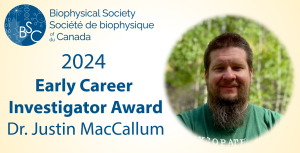In the words of Baljyot Parmar, last year’s recipient of the Trainee Paper Award, nominating a trainee is “a nice gesture for supervisors to take time from their busy schedule to encourage trainees and the work they are doing”.
You can read below how receiving a BSC Trainee Paper Award has impacted both 2021 recipients, Baljyot Parmar and Greg Gomes.
You now have until March 31st, 2022 to nominate one of your trainees for a Trainee Paper Award.

Baljyot Parmar is a PhD student at McGill University studying under Dr. Stephanie Weber. His research is focused on phase separation in cellular systems in which he studies the phase behaviour of proteins in bacteria using single-molecule tracking. His interest in biophysics comes from the many avenues it offers to be explored describing it as “a new field [where] everybody’s doing a random walk to [find] what niches they can fill.”
Baljyot is a recipient of the 2021 Trainee Paper Award for his paper “Clusters of bacterial RNA polymerase are biomolecular condensates that assemble through liquid-liquid phase separation.” This paper presents evidence of liquid-liquid phase separation occurring in E. coli through analysis of biochemical interactions and diffusion profiles. It is a shared first-author paper with Baljyot’s contributions involving performing single-molecule tracking to “quantify diffusion profiles of the proteins in different phases.” Baljyot describes a big challenge in this field is being able to definitively quantify phase separation in cellular systems experimentally. He compares the process of identifying phase separation to a checklist and feels that this paper has successfully identified examining diffusion profiles across phase boundaries as a necessary criterion to be added to the list.
Prior to Graduate school, Baljyot’s research experience was mainly focused on theoretical biophysics. He describes the shift to experimental research as a culture shock taking time to overcome. He is thankful for the diverse backgrounds within the Weber lab group as it provides an environment for biologists and physicists to collaborate and learn from each other emulating the true nature of biophysics.
When asked what advice he has for other trainees Baljyot recommends following what you find interesting. Returning to the checklist analogy, he feels there is no set of criteria that must be followed to guarantee groundbreaking research.
Receiving the Trainee Paper award was a surprise for Baljyot, “I didn’t even know [I was nominated] until I got accepted for the award” he said. He describes being nominated as a nice gesture for supervisors to take time from their busy schedules to encourage trainees and the work they are doing. It is this recognition that made receiving the award meaningful to him.

Dr. Greg Gomes completed his PhD in Biophysics at the University of Toronto Mississauga. He describes his graduate research in Dr. Claudiu Gradinaru’s lab as revolving around “the structural characterization of intrinsically disordered proteins (IDPs).” He now continues to work on “the themes of IDP structural characterization, single-molecule fluorescence, and integrative molecular models – but now applied to the molecular biophysics of aging and age-related disorders” in his postdoctoral work at Yale University in Dr. Zachary Levine’s lab.
Greg was the recipient of the 2021 Trainee Paper award for his paper titled “Conformational ensembles of an intrinsically disordered protein consistent with NMR, SAXS, and single-molecule FRET.” When asked what aspects of his research he is most proud of, he mentioned that he was “the recipient of good mentorship as an undergraduate and graduate student, and proud to be able to see current and past mentees of mine succeed in their endeavours.” After completing his post-doctoral research, Greg will be joining the Altos Labs, a biotechnology company that aims to find ways of restoring cell health and resilience and reversing diseases through cellular rejuvenation programming. He looks forward to collaborating with people there who are involved in cell biology and pathology, as he “really [wants] to understand, from a biophysical perspective, biological resilience to proteotoxic stressors”.
Commenting on the challenges faced during the completion of his PhD, Greg mentioned that he found it difficult to write papers early on as he did not have the confidence that others would be willing to read about his research findings. He was able to overcome this by understanding that his own results seemed to him to be “obvious -or uninteresting precisely because they were [his] results, and [he] knew them so intimately.” Acknowledging this and receiving guidance from good mentors has resulted in tremendous growth in his confidence. Receiving the Trainee Paper award has been another factor that has helped him grow his confidence and realize “the importance of having a supervisor or mentor who is always advocating on your behalf.”
When asked about advice on how to produce impactful research, his immediate thought was to recommend books and articles dissecting the craft of scientific thinking such as “The Art of Doing Science and Engineering” by Richard Hamming, “Science and Statistics” by George Box (Journal of the American Statistical Association, 1976), and “Strong Inference” by John R. Platt (Science, 1964).
Eligibility: The nominee must be a current or recent undergraduate, graduate, or postdoctoral trainee at a Canadian university, in any subfield of biophysics, who played a leading role in the nominated paper (published or in press within the calendar year preceding the nomination).
Nomination: The nomination package (English or French) must include:
- A cover letter from the nominator
- A PDF copy of the nominated paper
- A supporting letter from an arm’s length expert in the field OR a reviewer’s report for the paper
More information about the nomination process for trainee paper awards can be found on the BSC website.




